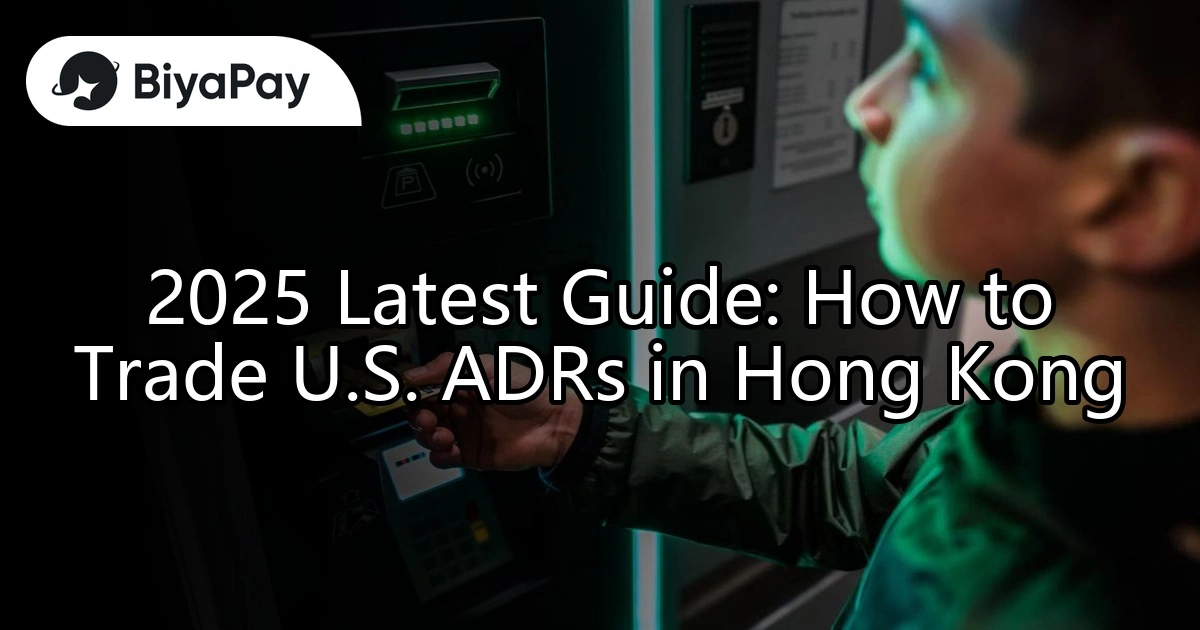- EasyCard
- Trade
- Help
- Announcement
- Academy
- SWIFT Code
- Iban Number
- Referral
- Customer Service
- Blog
- Creator
2025 Latest Guide: How to Trade U.S. ADRs in Hong Kong

Image Source: pexels
Do you want to trade U.S. ADRs in Hong Kong? In fact, you only need to open a securities account that supports U.S. stocks, such as Futu, Phillip Securities, or Bright Smart, complete identity verification, and then you can search and trade on the platform. This process is simple, and whether you are a beginner or an experienced investor, you can easily get started.
Key Points
- U.S. American Depositary Receipts (ADRs) allow you to trade foreign company stocks in the U.S. market using U.S. dollars without needing to open an overseas account.
- To trade ADRs in Hong Kong, you only need to open a securities account that supports U.S. stocks, complete identity verification, and then fund, search, and place orders.
- When investing in ADRs, pay attention to price volatility, exchange rate changes, taxes, and trading fees; choosing high-liquidity ADRs can reduce risks.
- Compare fees and services of different brokers, and use the platform’s smart tools to assist with stock selection and analysis to improve investment efficiency.
- Regularly check the latest prices and company information, pay attention to U.S. market trading hours, and seize the right timing for trading to make investments smoother.
Introduction to U.S. ADRs

Image Source: pexels
What Are U.S. ADRs?
You may have heard of U.S. American Depositary Receipts (ADRs) but are unclear about what they are. In fact, an ADR is a type of security listed on U.S. exchanges. It represents the stock of a non-U.S. company in the U.S. market. You can think of it as a “stock entry ticket” that allows you to trade shares of companies from China, Europe, or other regions in the U.S. market using U.S. dollars.
When you buy an ADR, a U.S. bank actually purchases the company’s stock in the overseas market and then “packages” these stocks into ADRs, enabling you to trade them in the U.S. market using U.S. dollars. This way, you can participate in investments in global major companies without needing to open an account overseas.
Tip: The full name of ADR is American Depositary Receipt. Just remember, it’s a tool that lets you trade foreign company stocks in U.S. dollars.
Key Features
U.S. ADRs have several distinct features. You can refer to the following list:
- You can trade directly in U.S. dollars without needing to exchange foreign currencies.
- Trading hours are the same as U.S. stocks, making it convenient for you to operate via online platforms in Hong Kong.
- ADRs are typically listed on major U.S. exchanges (e.g., NYSE, NASDAQ) with high liquidity.
- When you hold ADRs, you effectively own the equity of the corresponding company and can receive dividend distributions.
- U.S. ADRs make it easier for you to diversify investments and participate in leading companies from different countries.
These features make ADRs a popular choice for many Hong Kong investors. You only need to open a securities account that supports U.S. stocks to easily participate in global markets.
Trading Steps

Image Source: pexels
If you want to trade U.S. ADRs in Hong Kong, the process is very straightforward. You just need to follow the three steps below to easily participate in the U.S. market.
Account Opening and Verification
First, you need to choose a broker that supports U.S. stocks. Common choices in Hong Kong include Futu, Phillip Securities, and Bright Smart. You can select a local or overseas broker based on your needs. Different brokers vary in account opening methods, funding processes, and fees. The table below can help you quickly compare:
| Item | Chinese Brokers (Sub-Entrustment) | Overseas Brokers |
|---|---|---|
| Account Opening Method | Need to open a Chinese securities account and enable sub-entrustment function | Directly apply for an overseas broker account online |
| Funding Method | No need to remit overseas, operate directly in China | Need to wire transfer via Hong Kong bank to the broker’s designated bank |
| Fees | Approximately 0.251% per purchase, minimum USD 1,539.90 | Approximately 0~0.1% per trade, most without regular fixed-amount investment |
| Deposit/Withdrawal Fees | No overseas remittance fees | Approximately USD 3,658 per deposit, USD 1,035 per withdrawal (based on USD 1 = HKD 7.8) |
| Regulatory Authority | Chinese financial regulators | Overseas regulatory authorities |
| Trading Hours | Per broker’s rules | Per broker’s rules |
| Suitable Investors | Long-term investors with larger capital | Investors with smaller capital or frequent traders |
You just need to prepare identification documents and proof of address, and you can usually complete the account opening application online. Most brokers complete the review within a week. After opening the account, you also need to complete identity verification to ensure account security.
Tip: Some brokers offer commission-free promotions, which are especially suitable for beginners or small-amount investors. Compare the promotions and services of different platforms.
Funding and Searching
After opening an account, you need to deposit funds into the securities account. You can choose to wire transfer U.S. dollars from a Hong Kong bank to the broker’s designated bank account. According to market data, the average net deposit for new Hong Kong clients exceeds USD 30,000, indicating very active capital inflows. Funds typically arrive in 1-2 business days after deposit.
Many broker platforms have upgraded their features. For example, TigerAI’s smart research assistant has added features like watchlist and portfolio analysis, options assistants, etc., allowing you to quickly find your preferred U.S. ADRs. You just need to enter the company name or ADR code in the platform’s search bar to access relevant information.
- Platform features continue to innovate, lowering the investment threshold and enabling more people to efficiently participate in global markets.
- U.S. stock options trading order volume has significantly increased, reflecting growing investor interest in the U.S. market.
- The trade-sharing function supports displaying all orders and holdings for the past three months, making it easy to reference other users’ live trading strategies.
Note: Deposit and withdrawal fees vary by broker, so check the related fees in advance.
Order Placement and Settlement
Once you’ve funded your account and found the U.S. ADR you want to buy, you can place an order directly on the platform. You can choose a market order or limit order based on your strategy. After placing the order, the system will display the transaction status in real time.
In recent years, exchanges and brokers have continuously optimized settlement mechanisms. After placing an order, the platform automatically handles the settlement process, with funds and stocks typically settled on T+2 (two business days after the transaction). The newly introduced “one-stage” transfer mechanism simplifies the fund withdrawal and interest allocation process, allowing you to track funds more quickly.
- The Futures Trading Info Hub provides interactive charts and diverse features to help you quickly grasp market changes and improve operational accuracy.
- Smooth settlement processes improve capital utilization efficiency and reduce trading costs.
- Brokers continuously adjust and optimize settlement platforms based on market demand to ensure you can trade U.S. ADRs with confidence.
Tip: The U.S. market trading hours differ from Hong Kong’s, so pay attention to market opening and closing times to avoid missing ideal trading opportunities.
Risks and Fees
Main Risks
When investing in U.S. ADRs, you must pay attention to several key risks:
- Price Volatility: ADR prices fluctuate with the underlying company’s stock. If the original company is in China or Europe, significant local market changes will affect your ADR price.
- Exchange Rate Risk: You trade ADRs in U.S. dollars, but the original company may pay dividends in currencies like RMB or EUR. Exchange rate changes will affect your actual returns. For example, fluctuations in the USD to RMB exchange rate will impact the dividends you receive.
- Tax Issues: Different countries have different tax rates on dividends and capital gains. When you receive dividends, taxes may already be withheld. The U.S. generally withholds 30% dividend tax, but some countries have tax treaties with Hong Kong that may reduce certain taxes.
- Liquidity Risk: Some ADRs have low trading volumes, which may result in larger bid-ask spreads.
- Company Risk: If the original company faces financial issues, the ADR value will also plummet.
Tip: Choose ADRs listed on major U.S. exchanges (e.g., NYSE, NASDAQ) for better liquidity and regulation, reducing risks. If you’re unfamiliar with tax or exchange rate issues, consult a professional advisor.
Custody and Trading Fees
When trading ADRs, you also need to consider custody and trading fees. Below are common fees:
| Fee Type | Description | Typical Amount (in USD) |
|---|---|---|
| Trading Commission | Broker’s commission for buying/selling | Approximately USD 0~10 per trade |
| Custody Fee | Annual management fee charged by the issuing bank to ADR holders | Approximately USD 0.01~0.05 per share per year |
| Deposit/Withdrawal Fee | Fees for wiring funds to the broker or withdrawing | Approximately USD 20~50 per transaction |
| Exchange Rate Spread | Spread from currency conversion during trading | Varies based on current exchange rates |
Compare fees across brokers, as some platforms offer commission-free promotions suitable for small-amount or beginner investors. Calculate all fees to clearly understand the actual investment cost.
Tip: Regularly check broker announcements to stay updated on custody and trading fee adjustments to avoid unnecessary expenses.
Tips for Investing in U.S. ADRs
Dividends and Taxes
After buying U.S. ADRs, you will often receive dividends from the company. These dividends are paid in U.S. dollars and deposited directly into your securities account. Note that when dividends are paid, some countries may withhold taxes. For example, U.S. companies generally withhold 30% dividend tax. If the company is from China, the tax rate may differ. You can check the actual tax rate with your broker.
Some brokers automatically handle tax matters, so you don’t need to file separately. However, it’s best to regularly check your account records to ensure you receive the correct amount. You can also consult a professional tax advisor to understand whether you need to declare related income in Hong Kong or other regions.
Tip: If you hold ADRs long-term, pay attention to annual tax policy changes to avoid penalties for overlooking tax obligations.
Price Inquiry
Want to stay updated on the latest U.S. ADR prices? You can use broker platforms, financial news websites, or mobile apps to check. Most Hong Kong brokers provide real-time quotes and historical price charts. Just enter the company name or ADR code to view the latest price, trading volume, and related information.
Common inquiry methods include:
- Broker online trading platforms (e.g., Futu, Phillip Securities, Bright Smart)
- Financial information websites (e.g., Yahoo Finance, Google Finance)
- Mobile apps (most broker apps support U.S. ADR quotes)
Remember, U.S. market trading hours differ from Hong Kong’s. U.S. East Coast market hours are 9:30 PM to 4:00 AM (Hong Kong time, daylight saving time), so it’s best to place orders during this period for immediate execution. Orders placed outside trading hours will be processed on the next trading day.
Note: Some platforms offer free real-time quotes, while others may charge. Choose the inquiry method that suits your needs.
You’ve now mastered the basic process of trading U.S. ADRs in Hong Kong. In fact, the operation is not complicated. Just choose the right platform, follow the steps to open an account, fund it, and place orders. Many trading platforms now automatically integrate stock market data and company reports with real-time notification features, so you won’t miss any market changes. You can focus on analyzing data and reduce manual processing hassles. However, always pay attention to commissions, custody fees, and taxes, and assess your risk tolerance. As long as you keep learning and stay updated on the market, your investment journey will become smoother.
FAQ
1. Can you buy U.S. ADRs with Hong Kong dollars?
You need to convert Hong Kong dollars to U.S. dollars first. Most Hong Kong banks and brokers support HKD to USD conversion, with exchange rates based on the daily market.
Tip: Compare exchange rates across Hong Kong banks before converting to reduce costs.
2. Is there a minimum deposit requirement for trading ADRs?
Different brokers have different requirements. Some platforms require a minimum deposit of USD 100, while others may require USD 500 or more. Choose a platform based on your capital.
3. Can you trade ADRs on the same day?
Yes. You can buy and sell ADRs within U.S. market trading hours on the same day. However, be mindful of the time difference between the U.S. and Hong Kong.
4. Are ADR dividends automatically credited?
Yes. After the company pays dividends, the broker will automatically deposit the U.S. dollar dividends into your securities account. No additional action is required.
5. How do you check the latest ADR information?
You can use broker platforms, Yahoo Finance, or Google Finance to check ADR quotes, announcements, and company information. Just enter the company name or ADR code.
Trading American Depositary Receipts in Hong Kong is straightforward, but how can you streamline global investments? BiyaPay offers a seamless platform for trading US and Hong Kong stocks, including ADRs, without offshore accounts. Benefit from a 5.48% annualized yield savings product to boost returns.
Real-time exchange rate tracking and conversions support USD, HKD, and 30+ fiat and digital currencies, with global remittances to 190+ countries at fees as low as 0.5%. Sign up for BiyaPay today to enhance trading efficiency and seize global opportunities!
*This article is provided for general information purposes and does not constitute legal, tax or other professional advice from BiyaPay or its subsidiaries and its affiliates, and it is not intended as a substitute for obtaining advice from a financial advisor or any other professional.
We make no representations, warranties or warranties, express or implied, as to the accuracy, completeness or timeliness of the contents of this publication.




Contact Us
Company and Team
BiyaPay Products
Customer Services
is a broker-dealer registered with the U.S. Securities and Exchange Commission (SEC) (No.: 802-127417), member of the Financial Industry Regulatory Authority (FINRA) (CRD: 325027), member of the Securities Investor Protection Corporation (SIPC), and regulated by FINRA and SEC.
registered with the US Financial Crimes Enforcement Network (FinCEN), as a Money Services Business (MSB), registration number: 31000218637349, and regulated by FinCEN.
registered as Financial Service Provider (FSP number: FSP1007221) in New Zealand, and is a member of the Financial Dispute Resolution Scheme, a New Zealand independent dispute resolution service provider.



















